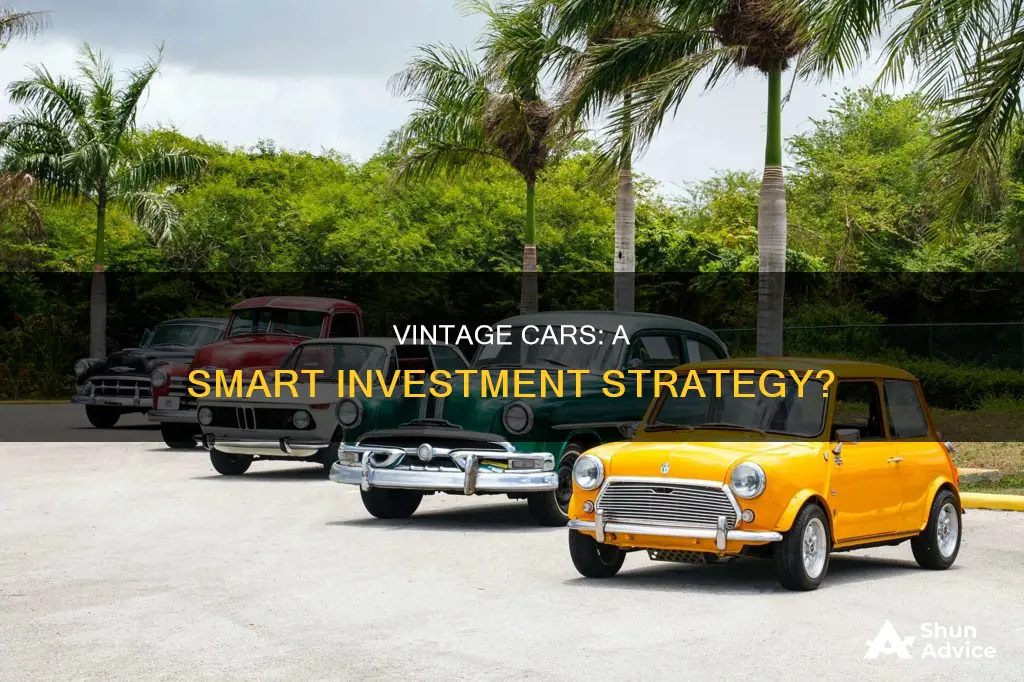
Vintage cars have become a sought-after asset class among the wealthy and investors. Over the past decade, vintage cars have experienced an impressive surge in value, outperforming other luxury assets like wine, watches, and art. According to Knight Frank's 2023 Wealth Report, vintage cars have seen a staggering 185% increase in value, second only to rare whiskies. This growth has attracted a broader investor base beyond collectors, with investors seeking the high returns and diversification benefits that classic cars offer over traditional assets.
However, investing in vintage cars is not without its challenges. The market can be volatile, and there are high barriers to entry, with minimum investment amounts often in the hundreds of thousands of dollars. Additionally, maintaining and preserving vintage cars can be expensive, with running costs, storage, and insurance fees amounting to a significant percentage of the portfolio's value annually.
Despite these challenges, the vintage car market remains attractive to investors, with the potential for substantial returns and the allure of owning a piece of automotive history.
| Characteristics | Values |
|---|---|
| Vintage car value increase | 185% increase in value over the past decade, second only to rare whiskies |
| Vintage car value compared to other luxury assets | Outpaced the growth of wine, watches, and art |
| Most expensive vintage car sold at auction | 1955 Mercedes-Benz 300 SLR Uhlenhaut Coupe sold for $149 million |
| Most popular vintage car brand sold at auction | Ferrari |
| Average auction value of Ferraris | $589,000 |
| Average auction value of Mercedes-Benz vehicles | $378,000 |
| Average auction value of Porsche vehicles | $348,000 |
| Factors that make a vintage car valuable | Rarity, historical significance, racing history, and celebrity ownership |
| Example of a rare vintage car | 1954 Mercedes-Benz 300 SL Gullwing with only 1400 units produced |
| Price range of the 1954 Mercedes-Benz 300 SL Gullwing | $1 million to $2.5 million |
| Example of a vintage car with racing history | Colin McRae’s 1998 Subaru 22B sold for over $600,000 in August 2023 |
| Example of a vintage car with celebrity ownership | Steve McQueen’s 1968 Ford Mustang GT sold for $3.74 million in January 2020 |
| Example of an affordable vintage car | Buick Reatta luxury coupe and convertible from the 1988 model year selling for around $10,903 |
| Example of a vintage car with the highest dollar-wise value increase | Porsche Carrera GT from 2004-2006 increased in value by $483,680 |
What You'll Learn

Vintage cars as a financial asset class
Vintage cars have become a sought-after asset class among the wealthy and investors. With exponential growth in the market, vintage cars have outperformed other luxury assets like wine, watches, and art in terms of value appreciation. This makes them a highly attractive investment option.
Market Performance
Over the past decade, vintage cars have experienced a surge in value, outpacing other luxury assets. According to Knight Frank's 2023 Wealth Report, vintage cars have seen a staggering 185% increase in value, second only to rare whiskies. This growth has caught the attention of investors, who are now recognising the financial potential of owning classic cars.
Factors Affecting Collectability and Value
Several factors contribute to a vintage car's collectability and value. These include:
- Rarity and limited production numbers: Cars produced in limited numbers or with unique customizations tend to be more desirable among collectors.
- Racing history: Cars with notable racing achievements are often seen as pieces of automotive history, increasing their value.
- Celebrity ownership: Cars previously owned by famous individuals often fetch higher prices at auctions, as they offer a unique connection to celebrities for collectors.
- Condition: The vehicle's condition plays a crucial role in its value. Regular maintenance is essential to preserve its value, as the further a car deviates from mint condition, the less value it commands.
- Historical significance: Cars with historical significance, especially those with a unique place in automotive history, tend to be more collectible.
Investment Considerations
While vintage cars can offer lucrative returns, there are challenges and considerations to keep in mind. Here are some key points to consider:
- High barrier to entry: Investing in vintage cars often requires substantial capital, with minimum investment amounts in the hundreds of thousands of dollars.
- Maintenance and preservation costs: Maintaining and preserving vintage cars can be expensive. Running costs, including storage, insurance, and repair fees, can amount to a significant percentage of the portfolio's value annually.
- Volatile market: The vintage car market can be volatile, subject to fluctuations in demand, changing trends, economic conditions, and collector interest.
- Due diligence: Investors must perform thorough due diligence before making investment decisions, as a car's condition, provenance, and rarity significantly impact its value.
Tips for Investing in Vintage Cars
If you're considering investing in vintage cars, here are some tips to keep in mind:
- Research and due diligence: Conduct extensive research and due diligence before investing. Use online valuation tools to track value and trends, and weigh the risks and merits of each investment opportunity.
- Focus on quality: Prioritize high-quality, well-maintained vehicles over quantity.
- Original parts: Choose cars with original parts or those that have been properly restored with documentation.
- Buy from reputable sources: Purchase from reputable dealers or well-known auctions to ensure authenticity and security of documentation.
- Keep records: If you plan to sell the car later, maintain detailed records of expenses for accurate valuation.
In conclusion, vintage cars have emerged as a lucrative financial asset class, offering substantial returns and the allure of owning a piece of automotive history. However, investing in vintage cars requires careful consideration of various factors, and it is essential to approach this asset class with a thorough understanding of the market and its unique challenges.
Understanding Investment Management Fees: Are You Overpaying?
You may want to see also

The high costs of maintenance and storage
Vintage cars have become a sought-after asset class among the wealthy and investors, with their value increasing by 185% over the past decade, outperforming luxury assets like wine, watches, and art. However, investing in vintage cars comes with high maintenance and storage costs that can impact the overall returns.
Maintenance Costs
Maintaining a vintage car can be expensive due to the specialised care and rare parts required. Owners need to allocate a significant budget for regular maintenance and repairs to preserve the vehicle's value. This includes routine checks, oil changes, brake maintenance, fluid replacements, and restoration work. The cost of maintenance can vary depending on the car's age, condition, and rarity, with rare or foreign cars often requiring higher costs for hard-to-find components and specialised mechanics.
Storage Costs
Storing a vintage car can be significantly more expensive than storing a regular vehicle. The cost of storing a vintage car depends on various factors, including location, type of storage, and additional amenities. Climate-controlled storage facilities, which help maintain battery and fluid levels, prevent damage, and protect the vehicle from extreme temperatures and humidity, can cost anywhere from $50 to $200 per month.
The size of the storage unit is another factor to consider, with larger vehicles requiring bigger units. Urban storage facilities tend to be more expensive than rural areas due to higher demand and limited space. Additionally, specialised collector car storage facilities, known as car condos, offer additional services such as maintenance, detailing, and a community for car enthusiasts, but they come at a higher price.
Additional Costs
In addition to maintenance and storage, there are other costs associated with owning a vintage car. Insurance for vintage vehicles is typically higher than standard auto insurance, ranging from $1,000 to $10,000 annually, depending on the vehicle's value and specialised coverage required. Registration and taxes can also add up, with costs varying by state and vehicle value.
Impact on Investment Returns
While vintage cars can be a lucrative investment, prospective buyers should be aware of the various expenses involved in owning and maintaining these vehicles. Proper research and budgeting are essential to ensure that the financial rewards outweigh the costs of this passion investment.
IFC's Private Equity Investment Strategy: Exploring the Facts
You may want to see also

Rarity and limited numbers
Cars produced in extremely limited runs, such as those with under 500 units ever made, tend to be more valuable. For example, the 1954 Mercedes-Benz 300 SL Gullwing originally had only 1400 units produced, and today, one of these cars could sell for between $1 and $2.5 million. Another example is the 1962 Ferrari 250 GTO, which sold for $48.4 million.
Additionally, cars that are the "first" in their category, such as the first Jeep Grand Cherokee to get the SRT treatment, or those that are ageing into a new generation of enthusiasts, like the 1980s Ferrari Testarossa, can also be more desirable and valuable.
The vintage car market has experienced exponential growth, with vintage cars outperforming other luxury assets like wine, watches, and art in value appreciation. This has attracted a broader investor base beyond just collectors, including investors seeking high returns and diversification benefits over traditional assets.
While investing in vintage cars can be lucrative, it is important to remember that it is not a guaranteed bet. The market can be volatile, and there are extra expenditures to consider, such as maintenance, storage, insurance, and auction or sales commissions.
Volcker Rule: Impact on Investment Management Firms?
You may want to see also

Racing history and celebrity ownership
Vintage cars have become sought-after assets among celebrities, investors, and collectors. The market has experienced exponential growth, with vintage cars outperforming other luxury assets like wine, watches, and art in value appreciation. This growth has attracted a new generation of investors who are aware of the financial potential of owning classic cars.
The most popular vintage car brand sold at auction is Ferrari, with a 1957 Ferrari 335 Sport Scaglietti selling for $35 million in 2016 and a 1956 Ferrari 290 MM selling for $28 million. However, the most expensive car ever sold at auction was a 1955 Mercedes-Benz 300 SLR Uhlenhaut Coupe, which sold for a staggering $149 million.
Celebrities have also jumped on the vintage car bandwagon, with some amassing impressive collections. Here are some notable examples:
- Robert Downey Jr. is a vintage car enthusiast and owns at least two dozen classic automobiles, including a 1965 Corvette Stingray, a 1970s Mustang, a 1970s Mercedes-Benz, an Audi R7 and R8, and a classic BMW 3.0CSi.
- Ralph Lauren, the famous fashion designer, owns a 1950 Jaguar XK120 Roadster, a 1962 Ferrari 250 GTO, a 1957 Jaguar XKSS, and a super-rare 1938 Bugatti Type 57SC Atlantic worth at least $40 million.
- Beyoncé, the pop star, owns a 1959 Rolls-Royce Silver Cloud II, a McLaren-Mercedes SLR, a Pagani Zonda F, and the only Maybach Exelero in existence. Her husband, Jay-Z, also possesses a collection of costly automobiles estimated to be worth $15 million.
- Eric Bana, the Australian actor, is a motoring enthusiast who owns a 1974 Ford Falcon XB, which he bought at the age of 15 after seeing the Mad Max movies. He even directed a documentary, "Love the Beast," about his relationship with the car.
- Jay Leno, the former host of "The Tonight Show", is known for his extensive collection of vintage automobiles, including a 1955 Buick Roadmaster, a 1967 Chevy C10, and a 1909 Baker Electric, which he claims is maintenance-free due to its high quality.
- Jerry Seinfeld is another celebrity with a vast car collection, including a 1959 Porsche 718 RSK, a Formula Two Grand Prix race car.
- Aaron Paul, the star of "Breaking Bad," owns a 1965 Shelby Cobra 427, one of the most famous cars built by Shelby American.
- Patrick Dempsey, the actor known for "Grey's Anatomy", owns a 1963 Porsche 356, a 1972 Jaguar E-Type, and a 1969 Mercedes-Benz 280SE. He also owns a racing team and has competed in multiple endurance racing championships.
- Lady Gaga, the musician, owned Elvis Presley's 1955 Cadillac DeVille while promoting her fifth studio album, "Joanne." She also has a collection of classic American cars, including a 1960s Ford Mustang, a Chevy El Camino, and a 1983 Mercedes-Benz W123 300D sedan.
These celebrities' passion for vintage cars showcases that the appeal of these classic vehicles goes beyond their monetary value, as they become a source of nostalgia, speed, and elegance.
Understanding Managed Investment Schemes in Australia: A Guide
You may want to see also

Vintage cars as a hobby vs an investment
Vintage cars have experienced an impressive surge in value over the past decade, outperforming other luxury assets like wine, watches, and art. This has transformed the classic car market, attracting not only collectors and enthusiasts but also investors looking to diversify their portfolios.
Vintage Cars as a Hobby
For many, vintage cars are an enjoyable hobby and a passion project. Owning a vintage car can be its own reward, providing fun, a sense of community, and the pleasure of driving and looking at a beautiful, historic vehicle. It's not just about making money, and some buyers are happy to spend more on restoration and maintenance to keep their vintage car in mint condition.
Vintage Cars as an Investment
Vintage cars can also be a good investment, but it's not a sure bet. The right vintage car, well-maintained and properly stored, can increase in value over time. Factors that can contribute to a car's value and collectability include rarity, historical significance, racing history, and celebrity ownership. For example, the 1962 Ferrari 250 GTO sold for $48.4 million, and the 1954 Mercedes-Benz W196 Silver Arrow sold for $29.7 million.
However, investing in vintage cars comes with challenges and considerations. There is a high barrier to entry, with minimum investment amounts often in the hundreds of thousands of dollars. Maintenance, storage, and insurance fees can also be expensive, and finding qualified mechanics for repairs can be difficult. The market can be volatile, and values can fluctuate with changing trends and collector interests.
Vintage cars can be both a hobby and an investment, but it's important to approach them with different mindsets. As a hobby, the focus is on the enjoyment and passion that comes with owning a piece of automotive history. As an investment, careful research and due diligence are required to navigate the challenges and risks of the classic car market.
Invest Wisely: Smart Home Improvement Choices
You may want to see also
Frequently asked questions
Vintage cars have experienced a 185% increase in value over the past decade, outperforming other luxury assets like wine, watches, and art. However, it's important to remember that not all vintage cars will increase in value, and there are risks associated with this type of investment.
Several factors make a vintage car more desirable and potentially more valuable. These include rarity, historical significance, racing history, and celebrity ownership. The condition of the vehicle is also crucial, as proper maintenance can help preserve its value.
Yes, investing in vintage cars carries risks. Maintenance and restoration costs can be high, and finding qualified mechanics for these specialised vehicles can be challenging. Storage and insurance expenses can also add up, and the market can be volatile, with values fluctuating based on trends and economic conditions.
Some notable examples include the Porsche Carrera GT from 2004-2006, which increased in value by $483,680 in a year, and the GMC Typhoon from 1992-1993, which saw a 59% jump in value. The Ferrari 250 GTO is another example, selling for $48.4 million.
To maximise your ROI, focus on picking the right vintage car. Look for rare vehicles with limited production numbers, notable racing history, or previous celebrity ownership. Additionally, conduct thorough research and due diligence, inspect for defects, and prioritise quality over quantity when purchasing.







